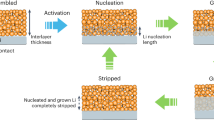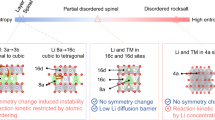Abstract
Lithium can be reversibly intercalated into layered Li1+xV1−xO2 (LiCoO2 structure) at ∼0.1 V, but only if x>0. The low voltage combined with a higher density than graphite results in a higher theoretical volumetric energy density; important for future applications in portable electronics and electric vehicles. Here we investigate the crucial question, why Li cannot intercalate into LiVO2 but Li-rich compositions switch on intercalation at an unprecedented low voltage for an oxide? We show that Li+ intercalated into tetrahedral sites are energetically more stable for Li-rich compositions, as they share a face with Li+ on the V site in the transition metal layers. Li incorporation triggers shearing of the oxide layers from cubic to hexagonal packing because the Li2VO2 structure can accommodate two Li per formula unit in tetrahedral sites without face sharing. Such understanding is important for the future design and optimization of low-voltage intercalation anodes for lithium batteries.
This is a preview of subscription content, access via your institution
Access options
Subscribe to this journal
Receive 12 print issues and online access
$259.00 per year
only $21.58 per issue
Buy this article
- Purchase on Springer Link
- Instant access to full article PDF
Prices may be subject to local taxes which are calculated during checkout






Similar content being viewed by others
References
Choi, N. S., Kim, J. S., Yin, R. Z. & Kim, S. S. Electrochemical properties of lithium vanadium oxide as an anode material for lithium-ion battery. Mater. Chem. Phys. 116, 603–606 (2009).
Song, J. H. et al. Electrochemical characteristics of lithium vanadate, Li1+xVO2, new anode materials for lithium ion batteries. J. Power Sources 195, 6157–6161 (2010).
Kim, S-S., Kim, J., Koike, M. & Kobayashi, N. 14th International Meeting on Lithium Batteries, Tianjin, China, Abstr. #20 (2008).
Kim, S-S., Nitta, Y., Nedoseykina, T. I. & Lee, J-C. US Patent Application US 2006/0088766 (2006).
Armand, M. & Tarascon, J-M. Building better batteries. Nature 451, 652–657 (2008).
Nazri, G-A. & Pistoia, G. (eds) Lithium Batteries Science and Technology (Kluwer Academic/Plenum, 2004).
Arico, A. S., Bruce, P. G., Scrosati, B., Tarascon, J. M. & Van Schalkwijk, W. Nanostructured materials for advanced energy conversion and storage devices. Nature Mater. 4, 366–377 (2005).
Bruce, P. G., Scrosati, B. & Tarascon, J. M. Nanomaterials for rechargeable lithium batteries. Angew. Chem. Int. Ed. 47, 2930–2946 (2008).
Huggins, R. A. in Handbook of Battery Materials (ed. Besenhard, J. O.) (Wiley-VCH, 1999) Part III, Chapter 4.
Winter, M. & Besenhard, J. O. Electrochemical lithiation of tin and tin-based intermetallic and composites. Electrochim. Acta 45, 31–50 (1999).
Mao, O. & Dahn, J. R. Mechanically alloyed Sn–Fe(–C) powders as anode materials for Li ion batteries. III. Sn2Fe:SnFe3C active/inactive composites. J. Electrochem. Soc. 146, 423–427 (1999).
Beaulieu, L. Y. & Dahn, J. R. The reaction of lithium with Sn–Mn–C intermetallics prepared by mechanical alloying. J. Electrochem. Soc. 147, 3237–3241 (2000).
Magasinski, A. et al. High-performance lithium-ion anodes using a hierarchical bottom-up approach. Nature Mater. 9, 353–358 (2010).
Amadei, I., Panero, S., Scrosati, B., Cocco, G. & Schiffini, L. The Ni3Sn4 intermetallic as a novel electrode in lithium cells. J. Power Sources 143, 227–230 (2005).
Graetz, J., Ahn, C. C., Yazami, R. & Fuetz, B. Highly reversible lithium storage in nanostructured silicon. Electrochem. Solid-State Lett. 6, A194–A197 (2003).
Yang, J. et al. Si/C composites for high capacity lithium storage materials. Electrochem. Solid-State Lett. 6, A154–A156 (2003).
Chan, C. K. et al. High-performance lithium battery anodes using silicon nanowires. Nature Nanotech. 3, 31–35 (2008).
Kepler, K. D., Vaughey, J. T. & Thackeray, M. M. LixCu6Sn5 (0<x<13): An intermetallic insertion electrode for rechargeable lithium batteries. Electrochem. Solid-State Lett. 2, 307–309 (1999).
Fransson, L. M. L. et al. Phase transitions in lithiated Cu2Sb anodes for lithium batteries: An in situ X-ray diffraction study. Electrochem. Commun. 3, 317–323 (2001).
Poizot, P., Laruelle, S., Grugeon, S., Dupont, L. & Tarascon, J-M. Nano-sized transition metal oxides as negative electrode material for lithium-ion batteries. Nature 407, 496–499 (2000).
Leroux, F., Coward, G. R., Power, W. P. & Nazar, L. F. Understanding the nature of low-potential Li uptake into high volumetric capacity molybedenum oxides. Electrochem. Solid-State Lett. 1, 255–258 (1998).
Taberna, P. L., Mitra, S., Poizot, P., Simon, P. & Tarascon, J. M. High rate capabilities Fe3O4-based Cu nano-architectured electrodes for lithium-ion battery applications. Nature Mater. 7, 567–573 (2006).
Pereira, N., Dupont, L., Tarascon, J. M, Klein, L. C. & Amatucci, G. G. Electrochemistry of Cu3N with lithium — A complex system with parallel processes. J. Electrochem. Soc. 150, A1273–A1280 (2003).
Li, H., Ritcher, G. & Maier, J. Reversible formation and decomposition of LiF clusters using transition metal fluorides as precursors and their application in rechargeable Li batteries. Adv. Mater. 15, 736–739 (2003).
Badway, F., Cosandey, F., Pereira, N. & Amatucci, G. G. Carbon metal fluoride nanocomposites: High capacity reversible metal fluoride conversion materials as rechargeable positive electrodes for Li batteries. J. Electrochem. Soc. 150, A1318–A1327 (2003).
Pralong, V., Souza, D. C. S., Leung, K. T. & Nazar, L. Reversible lithium uptake by CoP3 at low potential: Role of the anion. Electrochem. Commun. 4, 516–520 (2002).
Peled, E. The electrochemical-behaviour of alkali and alkaline-earth metals in non-aqueous battery systems—the solid electrolyte interphase model. J. Electrochem. Soc. 126, 2047–2051 (1979).
Fong, R., von Sacken, U. & Dahn, J. R. Studies of lithium intercalation into carbons using nonaqueous electrochemical-cells. J. Electrochem. Soc. 137, 2009–2013 (1990).
Besenhard, J. O., Winter, M., Yang, J. & Biberacher, W. Filming mechanism of lithium-carbon anodes in organic and inorganic electrolytes. J. Power Sources 54, 228–231 (1995).
Park, S-Y., Choi, N-S., Yew, K-H., Lee, D-K. & Kim, S-S. US Patent Application US 2009/0068566 (2009).
David, W. I. F., Goodenough, J. B., Thackeray, M. M. & Thomas, M. G. S. R. The crystal-structure of Li2MnO2 . Rev. Chim. Miner. 20, 636–642 (1983).
Dahn, J. R., Von Sacken, U. & Michal, C. A. Structure and electrochemistry of Li1+/−yNiO2 and a new Li2NiO2 phase with the Ni(OH)2 structure. Solid State Ion. 44, 87–97 (1990).
Davidson, I., Greedan, J. E., Von Sacken, U., Michal, C. A. & Dahn, J. R. Structure of 1 T–Li2NiO2 from powder neutron-diffraction. Solid State Ion. 46, 243–247 (1991).
Johnson, C. S. et al. The role of Li2MO2 structures (M=metal ion) in the electrochemistry of (x)LiMn0.5Ni0.5O2·(1−x)Li2TiO3 electrodes for lithium-ion batteries. Electrochem. Commun. 4, 492–498 (2002).
Johnson, C. S. et al. Structural characterization of layered LixNi0.5Mn0.5O2 (0<x≤2) oxide electrodes for Li batteries. Chem. Mater. 15, 2313–2322 (2003).
Islam, M. S., Driscoll, D. J., Fisher, C. A. J. & Slater, P. R. Atomic-scale investigation of defects, dopants and lithium transport in the LiFePO4 olivine-type battery material. Chem. Mater 17, 5085–5092 (2005).
Kendrick, E., Kendrick, J., Knight, K. S., Islam, M. S. & Slater, P. R. Cooperative mechanisms of fast-ion conduction in gallium-based oxides with tetrahedral moieties. Nature Mater. 6, 871–874 (2007).
Catlow, C. R. A. (ed.) Computer Modelling in Inorganic Crystallography (Academic, 1997).
Zhou, F., Cococcioni, M., Marianetti, C. A., Morgan, D. & Ceder, G. First principles prediction of redox potentials in transition-metal compounds with LDA+U. Phys. Rev. B 70, 235121 (2004).
Kang, K. S., Meng, Y. S., Breger, J., Grey, C. P. & Ceder, G. Electrodes with high power and high capacity for rechargeable lithium batteries. Science 311, 977–980 (2006).
Arrouvel, C., Parker, S. C. & Islam, M. S. Lithium insertion and transport in the TiO2–B anode material: A computational study. Chem. Mater. 21, 4778–4783 (2009).
Braithwaite, J. S., Catlow, C. R. A., Gale, J. D., Harding, J. H. & Ngoepe, P. E. Calculated cell discharge curve for lithium batteries with a V2O5 cathode. J. Mater. Chem. 10, 239–240 (2000).
Scanlon, D. O., Walsh, A., Morgan, B. J. & Watson, G. W. An ab initio study of reduction of V2O5 through the formation of oxygen vacancies and Li intercalation. J. Phys. Chem. C 112, 9903–9911 (2008).
Meng, Y. S. & Arroyo-de Dompablo, M. E. First principles computational materials design for energy storage materials in lithium ion batteries. Energy Environ. Sci. 2, 589–609 (2009).
Hodnett, B.K., Permanne, Ph. & Delmon, B. Influence of p/v ratio on the phase composition and catalytic activity of vanadium phosphate based catalysts. Appl. Catalys. 6, 231–244 (1983).
Coelho, A. A. Whole-profile structure solution from powder diffraction data using simulated annealing. J. Appl. Crystallogr. 33, 899–908 (2000).
Gale, J. D. & Rohl, A. L. The general utility lattice program. Mol. Simul. 29, 291–341 (2003).
Kresse, G. & Furthmüller, J. Efficient iterative schemes for ab initio total-energy calculations using a plane-wave basis set. Phys. Rev. B 54, 11169 (1996).
Vanderbilt, D. Soft self-consistent pseudopotentials in a generalized eigenvalue formalism. Phys. Rev. B 41, 7892–7895 (1990).
Burke, K., Perdew, J. P. & Wang, Y. in Electronic Density Functional Theory: Recent Progress and New Directions (eds Dobson, J. F. & Vignale, G.) (Plenum, 1998).
Yin, R. Z., Kim, Y. S., Choi, W. U., Kim, S. S. & Kim, H. J. Structural analysis and first-principles calculation of lithium vanadium oxide for advanced Li-ion batteries. Adv. Quantum Chem. 54, 23–33 (2008).
Acknowledgements
P.G.B. and M.S.I. are indebted to the European Union and EPSRC for financial support. The computations were run on the HECToR facilities via the Materials Chemistry Consortium.
Author information
Authors and Affiliations
Contributions
A.R.A. and C.L. carried out the experimental work and data analysis, P.M.P. the modelling, M.S.I. and P.G.B. conceived and directed the project.
Corresponding authors
Ethics declarations
Competing interests
The authors declare no competing financial interests.
Supplementary information
Supplementary Information
Supplementary Information (PDF 5616 kb)
Rights and permissions
About this article
Cite this article
Armstrong, A., Lyness, C., Panchmatia, P. et al. The lithium intercalation process in the low-voltage lithium battery anode Li1+xV1−xO2. Nature Mater 10, 223–229 (2011). https://doi.org/10.1038/nmat2967
Received:
Accepted:
Published:
Issue Date:
DOI: https://doi.org/10.1038/nmat2967
This article is cited by
-
The facile fabrication of Li3VO4/N-doped graphene hybrid for superior lithium storage
Ionics (2022)
-
Exfoliated MoS2–Polyaniline Nanocomposites: Synthesis and Characterization
Journal of Inorganic and Organometallic Polymers and Materials (2020)
-
MOFs-derived MnCo2O4 nanowires with porous structures for lithium-ion battery anodes
Journal of Materials Science: Materials in Electronics (2019)
-
Partial surface phase transformation of Li3VO4 that enables superior rate performance and fast lithium-ion storage
Tungsten (2019)
-
MoS2/C/C nanofiber with double-layer carbon coating for high cycling stability and rate capability in lithium-ion batteries
Nano Research (2018)



